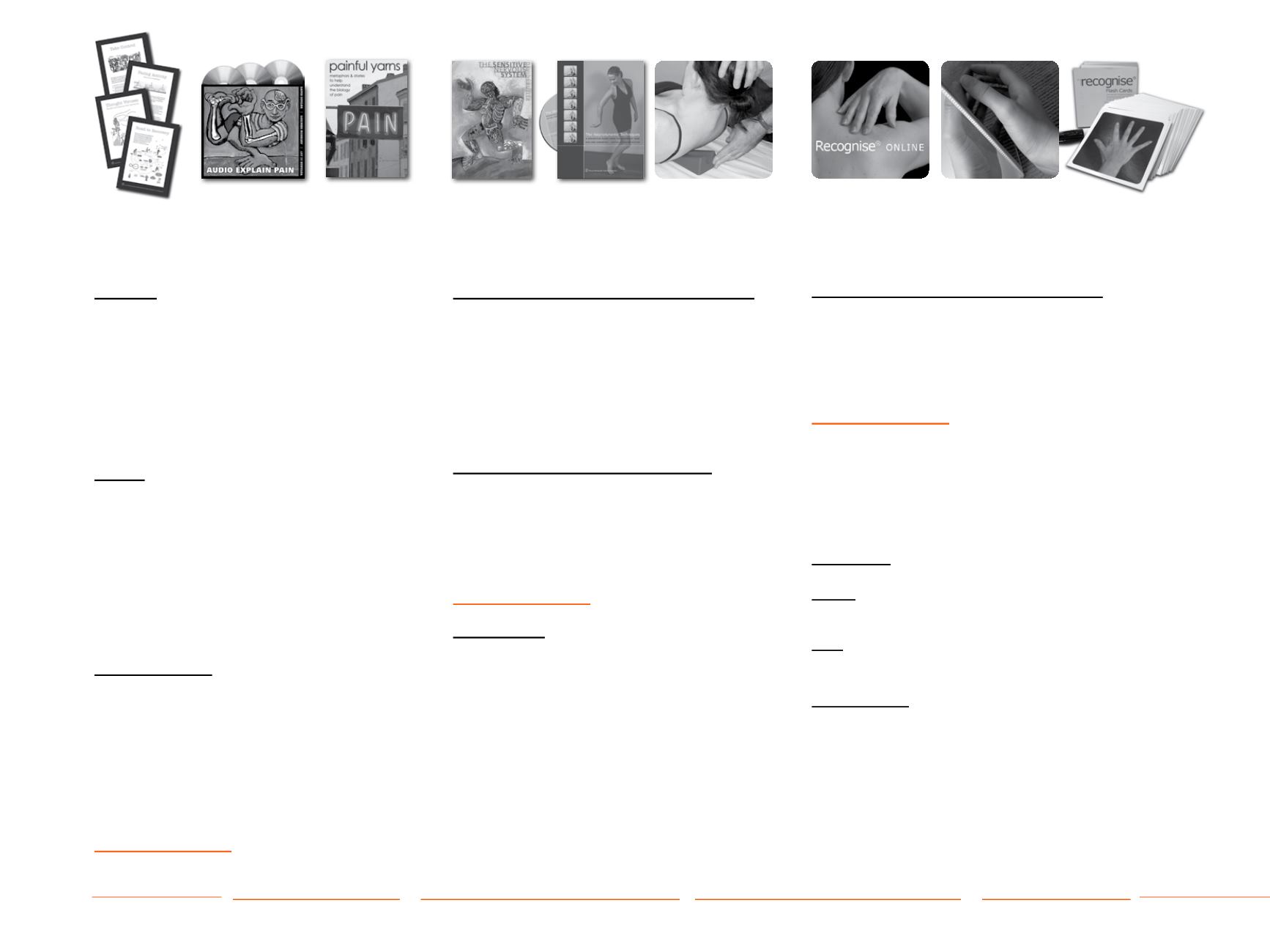
Selected images and concepts presented in poster
format and designed to help clinicians and their
patients in the recovery journey. The posters can
be used in a pain peer group setting, in the
treatment room or on the waiting roomwall. The
four titles encourage empowerment, helping pain
sufferers tomake informed choices and guide
them to recovery: ‘Take Control’, ‘Pacing Activity’,
‘Thought Viruses’, ‘The Road to Recovery’.
English / Portuguese
Explain Pain
and the philosophy and research
behind it have become a huge influence on pain
management across the English speaking world
since its release in 2003. Combine reading with
listening tomake themost of the ground breaking
work of
Explain Pain
- Moseley and Butler will
talk you through it with over three hours of
listening time on the CDs tomake reading easier
and retaining the knowledgemore effective. The
CD set is great to play in the car or on themove
with themp3 player.
Thismuch anticipated collection of stories, written
byNeuroscientist and co-author of
Explain Pain
,
LorimerMoseley, provides an entertaining and
informativeway tounderstandmodern pain biology.
Described by critics as ‘a gem’ and by clinicians as
‘entertaining and educative’,
Painful Yarns
is a
unique book. The stories and experiences are great
yarns, backed up bymetaphors to pain biology.
The level of the pain education is appropriate for
patients and professionals, the entertainment is
good for everyone.
NOIs international group of faculties presents the
definitivemanual of neurodynamic techniques for
everyday clinical use. This DVD and handbookwill
helpwith the assessment andmanagement of
physical health and sensitivity issues related to
peripheral and central nervous system based pain
presentations.
NTSC Englishwith subtitles in
Spanish andPortuguese / PALEnglishwith subtitles
inGerman, Italian, Spanish and ChineseMandarin.
This text calls for skilled combined physical and
educational contributions to themanagement of
acute and chronic pain states.
It offers a ‘big picture’ approach using best
evidence from basic sciences and outcomes data,
with plenty of space for individual clinical
expertise andwisdom.
Our wedge is light, strong and allows very
localised active andmassivemobilisation of
joint and neural tissue in the thoracic spine.
These techniques are demonstrated in the
Neurodynamic Techniques DVD andHandbook
and onNOI courses.
Written by the principal researchers and educators
of the GMI concept, this bookwill guide you
through the science behind and the process of
GMI. Essentially a series of brain exercises, GMI
involves body part left/right discrimination, motor
imagery andmirror therapy. The handbook is
suitable for both patients and clinicians.
Recognise
TM
Even simple exercisesmay cause pain if your brain
can’t recognisewhether you are using your left or
right side. This can be tested easily and quickly
using theRecognise
TM
programme. This novel
evidence-based programme can provide valuable
help in themanagementmany chronic pain states.
| These cards complement Recognise
TM
online and are the first step in theGMI programme.
|Ameasurable, progressive self-management
tool for patients. Test results can be collected and
analysed.
The newRecognise
TM
Appmeans you can
quickly exercise your synapses on your iphone or
ipadwherever you are.
Mirrorsmay be used to gain relief and better
movement for a variety of pain and disability
states, especially those involving the hands and
feet. In particular, mirror therapymay be
appropriate for problems such as complex regional
pain syndrome, phantom limb pain, arthritis,
stroke and focal dystonia.
English / German / Italian / Portuguese
Explain Pain resources
Neurodynamic resources Brain training resources
|
|


